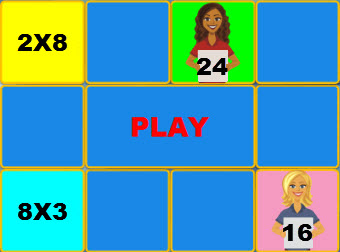
Make a deck of fact family triangles.Īnother project for kids to help them personalize their learning.

If students are doing this activity at home and do not have paper plates, they can make the circles out of regular paper. This can also double as a craft activity allowing students to get as creative as they want when they decorate their plates. Teach multiplication facts with a simple wheel.Īll it takes is paper plates, glue, and a marker to help your students learn their multiplication tables. They take a lot of pride in them as the cards aren’t just another set of flashcards.” 7. They keep them in their binders so that any time we have five minutes to spare, they can practice. “I teach fourth grade, and the kids have been very eager to make the cards at home. so the brain makes a connection between the answer and the drawing,” she says. “Have students put an artistic drawing to their flashcard answers. Let kids make their own multiplication facts flashcards. If students have access to an empty egg carton at home, this could also be an at-home practice activity. Write the math sentence and answer on a sheet of paper. Shake the egg carton, open the top, and then multiple whichever two numbers the marbles have landed on. Place two marbles inside the egg carton and close the lid. Using an egg carton, have students write the numbers 1-12 in the bottom of each depression. Repurpose an egg carton as a multiplication problem generator. Choose two other students to be the “guessers.” Rotate shooters and guessers. If you’re playing all together virtually, choose a student to be your partner, then shoot. If students are playing in pairs, the first partner to multiply the two sets of fingers together and call out the product gets a point. It’s just like the game Roshambo (aka Rock, Paper, Scissors), but students put up fingers instead of rock, paper, or scissors. This is a quick, easy activity that gets kids moving while they’re learning. Put a mathematical twist on an old favorite.

This activity can be played in person or virtually. Each student’s card is unique, and they can take pride in creating their own game. The students solve the product and, if that number is on their grid, cover that number with a bean or tile. The teacher calls multiplication problems, for example, 7×9. Have students make their own cards by using the backside of any paper to draw a 5×5 grid and filling in the boxes with product numbers such as 16, 8, 48. At the end of the game, the player with the most cards wins. If students are playing with a partner, both students flip two cards, multiply the numbers together and whoever has the highest product keeps the cards.


You can assign a time limit, like ten minutes, or a number of problems, like six problems. Next, they write the math sentence on a piece of paper and solve the problem. Then they multiply the two numbers on the cards together. To begin, students flip two cards face up. If not, they can make their own number cards using index cards or scrap paper. Hopefully, most of your students have an ordinary deck of playing cards at home. This activity can be used for one person or for a pair.
Tactile games for multiplication download#
To make it easy as an in-home assignment, make a blank template that your students can download at home. Last, draw another 12 petals and write the product of the center number and the petal adjacent to the new petal. Next, draw 12 petals around the center, labeling them 1–12. Start by drawing the center of a flower and write any number 1–9 in the middle. This is a creative way to teach multiplication facts.


 0 kommentar(er)
0 kommentar(er)
